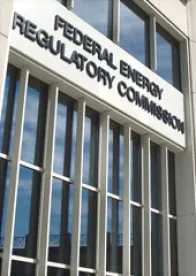On March 21, 2019, the Federal Energy Regulatory Commission (FERC or Commission) initiated a Notice of Inquiry (NOI) to examine whether, and if so how, to revise its policies concerning the determination of the return on equity (ROE) used in setting jurisdictional rates. Although primarily focused on ROE for electric utilities, FERC specifically solicits comments on whether it should revise its policies for calculating ROEs for interstate natural gas and oil pipelines.
FERC appears open to reconsidering its longstanding sole reliance on the DCF methodology to set pipeline returns. The NOI includes a long series of questions directed at examining its methodology for calculating ROE.
Initial comments are due 90 days after the NOI has been published in the Federal Register, and reply comments are due 30 days after the initial comment deadline.
Background
Last fall, in a proceeding concerning ROE for electric utility transmission owners in ISO New England, FERC issued a landmark order (Order), summarized here, setting forth a new proposed framework for: (i) determining whether an existing return on equity (ROE) has become unjust and unreasonable and (ii) establishing a new just and reasonable ROE. In a departure from its previous reliance on the two-step discounted cash flow (DCF) methodology, which also applies to natural gas pipelines, FERC’s proposed framework would determine ROE by according equal weight to the results of four financial models—DCF, the Capital Assets Pricing Model (“CAPM”), Expected Earnings, and Risk Premium. That Order called for a paper hearing process to implement the framework and acknowledged that the paper hearing may define necessary adjustments to the use of the four methods. Shortly thereafter, the Commission initiated a similar paper hearing process in a separate proceeding concerning ROE for electric utility transmission owners in MISO. Subsequently, this issue arose in the Trailblazer Pipeline Company’s Section 4 rate case and is now included in the evidentiary hearing in that case.
Given the implications its new ROE framework may have on regulated entities, including interstate natural gas and oil pipelines, the Commission is initiating the NOI to seek further information as it continues to re-evaluate its ROE policies.
FERC Seeks Comment on Eight Topics
The NOI specifies eight categories of issues and poses specific questions within each category. Below are the eight categories, including a summary of some of the more significant questions asked in each category.
1. The role of FERC’s base ROE in investment decision-making and what objectives should guide the FERC’s approach:
The NOI asks whether FERC should consider a “vintage approach” to ROE, “with ROE fixed for the life of the asset at the time that each asset was completed”? FERC also seeks comments on whether a “vintage approach,” if adopted, would need to be coupled with an annual national default ROE for investments made in that year, in order to minimize litigation.
2. Whether FERC should apply a single ROE policy across electric, interstate natural gas and oil pipeline industries:
Recognizing that it has previously applied the same DCF methodology to the electric, natural gas and oil pipeline industry, FERC’s NOI seeks comment on whether it should apply any new ROE policy it adopts for electric utilities to natural gas and oil pipelines as well. FERC also asks whether adjustments to any of its proposed methodologies (i.e., CAPM, Expected Earnings, Risk Premium) would need to be made if applied to natural gas and oil pipelines
3. The DCF model’s performance;
FERC seeks comment on the robustness of the DCF model over time and under differing investment conditions, such as under a wide range of interest rates.
4. The composition of proxy groups;
FERC asks about the appropriate guidelines for proxy group composition, elimination of outliers, and placement of base ROE within a zone of reasonableness. FERC asks whether proxy groups for electric utilities, natural gas pipelines and oil pipelines should be expanded to include other energy or non-energy companies. FERC acknowledges constructing proxy groups of sufficient size for natural gas and oil pipelines, and seeks comment on this issue.
5. The choice of financial model(s) used;
FERC requests comment on other financial models (aside from the DCF, CAPM, Risk Premium, and Expected Earnings models) used by investors to evaluate investment options, and the strengths and weaknesses of such other models.
6. The mismatch between market-based ROE determinations and book-value rate base;
FERC asks whether the mismatch between market-based ROE determination and a book value rate base is problematic, and, if so, whether FERC should consider adjusting ROEs to account for such a mismatch.
7. How FERC determines whether an existing ROE is unjust and unreasonable under the first prong of Federal Power Action section 206; and
FERC poses a number of questions regarding its methodology for evaluating ROEs in complaint proceedings. Since the rate setting provisions of the Federal Power Act and Natural Gas Act are largely parallel, these questions may be relevant to pipelines.
8. The mechanics and implementation of the models.
Finally, FERC asks a number of model-specific questions regarding the mechanics and implementation of the DCF, CAPM, Expected Earnings, and Risk Premium models.
Implications for Natural Gas Pipelines
FERC’s broad list of questions provides natural gas pipelines with a unique opportunity to address a number of significant issues that may have far-reaching industry impacts. Specifically, FERC opens the door to comments on natural gas pipeline’s proxy group composition – a matter which has been challenging for the industry for at least the past several years. FERC’s NOI also indicates a willingness to consider the use of other metrics to be used in determining ROE for MLP pipelines.




 />i
/>i
